Verifying investment precious metals is a simple procedure that everyone can do. Therefore, there is no need for long training courses or expensive equipment. Today we discover how easy it is to distinguish authentic investment gold and silver from fake ones.
👉 Read also: Tools to Test Investment Gold and Silver 🎬
Run more tests:
I invite you to carry out all the most suitable tests for each type of object to be verified. Do not rely on a single result, but on several: it may happen that some fakes result authentic in some tests.
Indice
- (00:20) Color 🧮
- (08:13) Magnet 🧲
- (15:12) Mass and Dimensions 📟📏
- (21:06) Density 💧
- (27:57) Sound frequency 🎶
- (34:41) Diamagnetism 🧭
- (42:26) Sound speed 🔊
- Other unreported tests 🧪
#1. Color 🧮
The color that an object displays allows us to exclude in the blink of an eye some fakes that should, due to their composition, present a different color.
In fact, it is sufficient to know the purity (title) that our object should have to exclude some fakes by observing its color. In the case of coins, often composed of gold of various titles, we can trace their purity by doing a search on Numista.com or more generally in search engines.
Verification procedure for gold
- Gold bars or ingots are always very pure and therefore 24kt (.999), their color will therefore always be yellow gold. There may be rare cases in which the purity is lower and they are linked to copper, their color will therefore be gold tending a little towards reddish.
- Gold coins are usually 24kt, 22kt (.916) or 21.6kt (.900). While the first will be yellow gold in color, the last two are almost always linked to copper and their color will also tend a little towards reddish. In some rarer cases, they can also be partly linked to silver, which gives a color tending more towards yellow than red.
- Gold plates are always 24kt and therefore yellow gold in color.
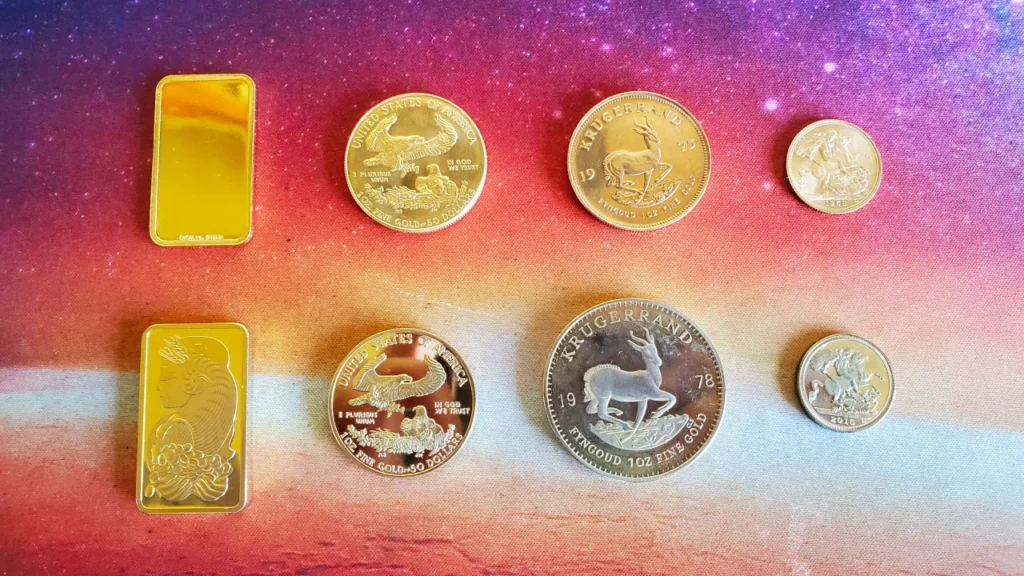
Red spots and pyrite
Some gold coins of various denominations may have small spots of red, blue or brown. There is absolutely no need to worry: they can be caused by an inhomogeneous mixing of copper, micro impurities or chemical reactions.
👉 Read also: (ITA 🇮🇹 Only) Il Perché delle Macchie Rosse sulle Monete d’Oro
For those who are afraid of pyrite (fool’s gold), know that its color is visibly different from that of gold and tends more towards green than yellow.
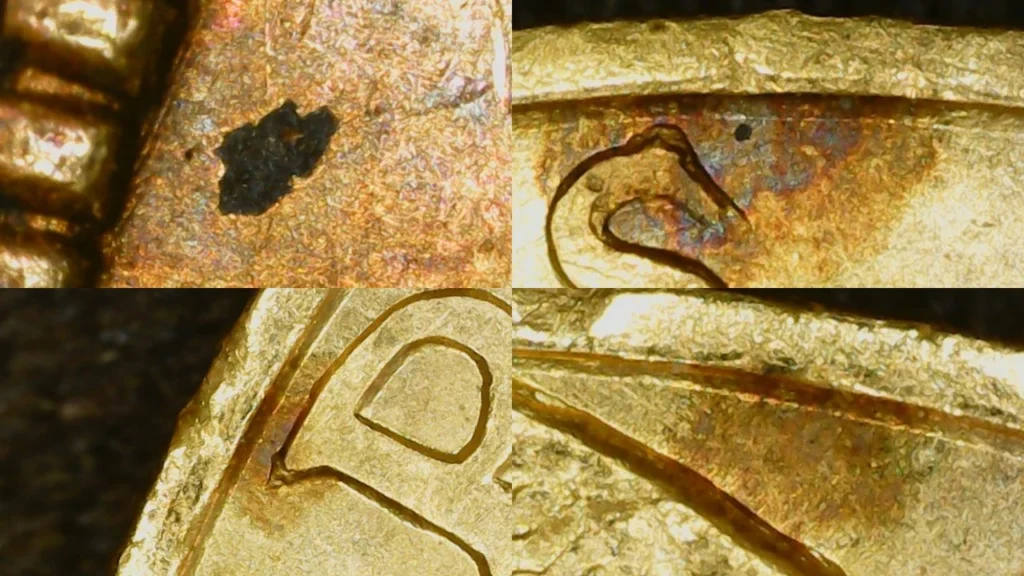
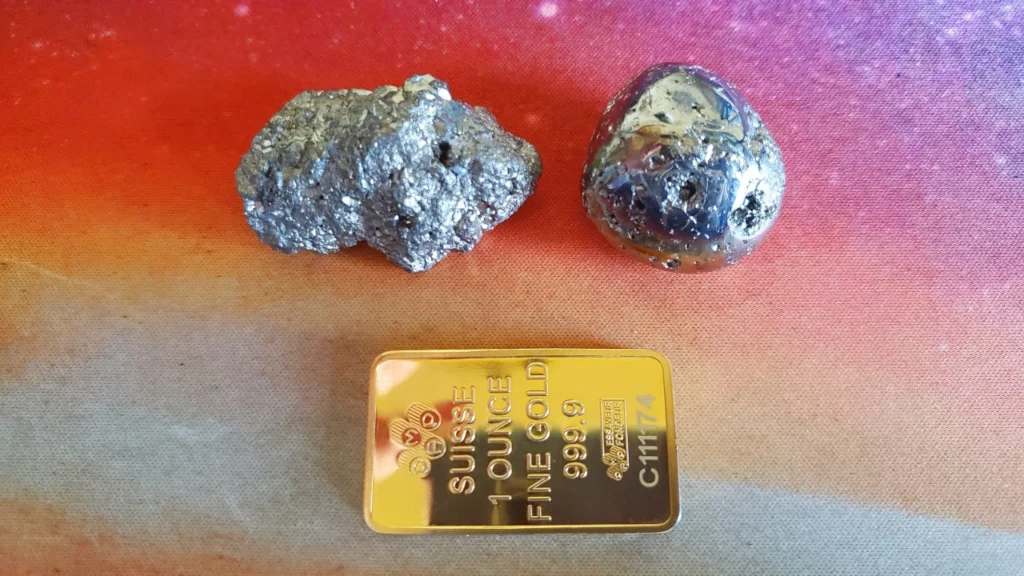
Verification procedure for silver
As for silver, however, it is more difficult to distinguish real objects from fake ones by color alone. In fact, the vast majority of fake silver is made of cupronickel, an alloy with a variable proportion of copper and nickel. This alloy, combined with subsequent chemical processes, can easily resemble any authentic silver object, whether pure or of various grades.
Furthermore, silver tends to oxidize quite easily and therefore, by blackening over time, it will be even more easily falsifiable at a visual level with alloys and processes suitable for the purpose.
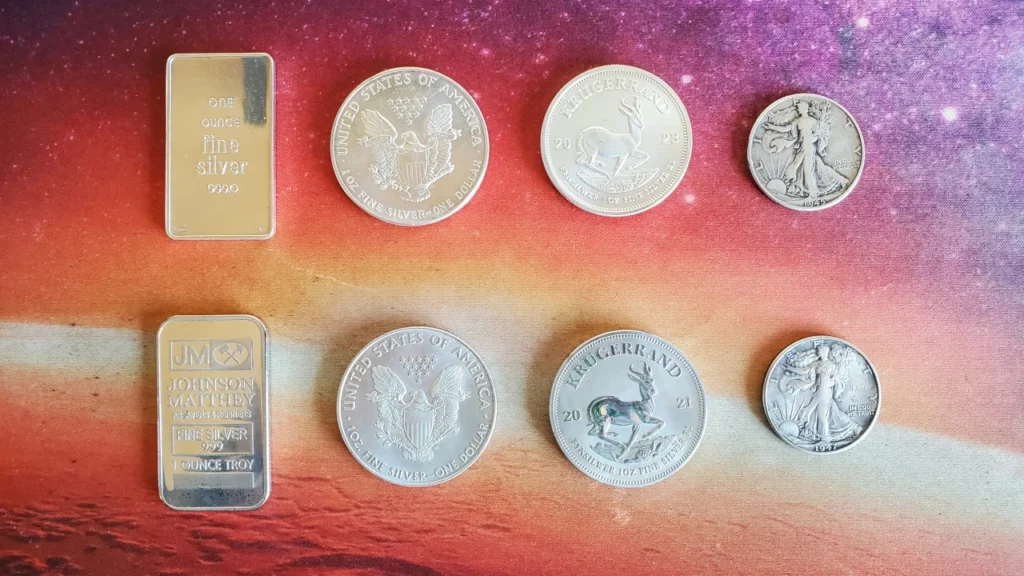
#2. Magnet 🧲
Attention:
Not suitable for non-24k gold.
First of all, precious metals are not magnetic, so if a magnet were to stick to a coin or an ingot, it would certainly be a fake.
Then we can use Lenz’s law: when a magnet moves near a material with good electrical conductivity, it generates eddy currents in the metal. These currents create a magnetic field opposite to the movement of the magnet, visibly slowing it down.
This effect is clearly observed in metals that conduct electricity, while it is absent in non-conductors. For this reason, Lenz’s law is useful for checking the approximate composition of a coin or an ingot. Here are the 3 best conductive metals:
- Silver is the best conductor of electricity but expensive and subject to oxidation,
- Copper is the most used thanks to its excellent ratio between conductivity and cost,
- Gold is an excellent conductor, very resistant to oxidation, but very expensive.
Verification procedure
Tools used:
Hold the object at a 45° angle and slide a small neodymium magnet over it. If the magnet slows down (but doesn’t stick!), you probably aren’t dealing with a fake. This test usually helps rule out anything that isn’t gold, silver, or copper.
Non-24k gold items
However, when the object is made of gold mixed with other metals (even if they are good conductors like copper), the resulting alloy will not make the magnet slide slowly. Consequently, only 24kt gold coins and bars would give consistent results with this type of test.
This happens because in objects not made of gold alone, the structure of the alloy is less homogeneous. This leads to a dispersion of the energy of the magnetic field through the different components of the alloy, further reducing the braking effect of the eddy currents that slow down the magnet.
For silver, however, this problem does not occur. Any silver object of any title will slow down the descent of the magnet, proportionally to the amount of silver present.
👉 Read also: (ITA 🇮🇹 Only) Perché il Magnete Non Rallenta sull’Oro Non 24K
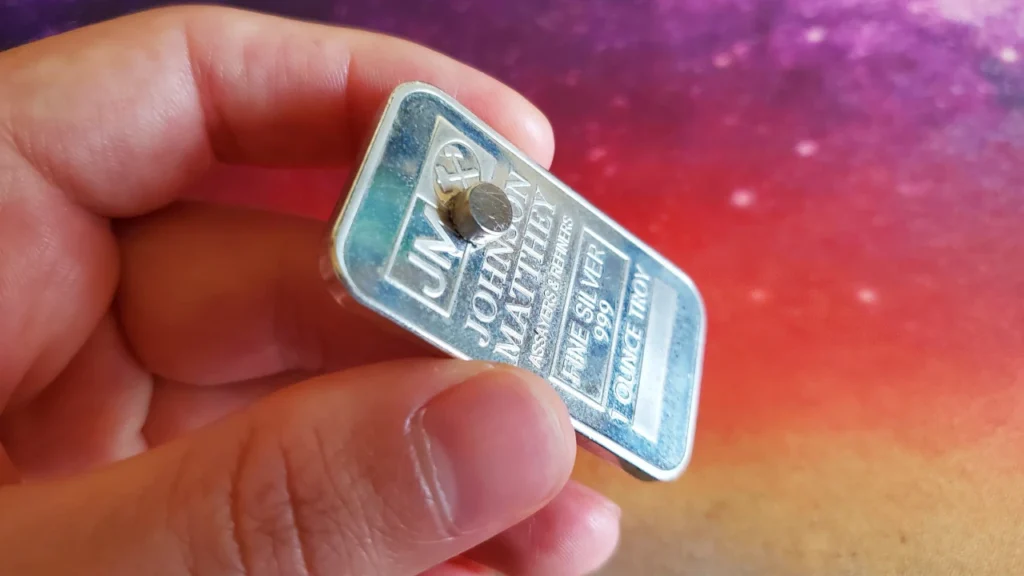
#3. Mass e Dimensions 📟📏
Attention:
Only partially suitable for packaged bars.
Measuring the mass and size are simple methods of verifying the authenticity of a coin or bar. If the mass or size differs significantly from the standard, it could be a fake unless the item is visibly worn.
In packaged bars, the packaging adds weight, but if the total mass is less than the weight of the bar plus the estimated weight of the packaging, then you should be suspicious. In addition, in these bars, the base and height can be easily measured, while the thickness requires a visual assessment to determine if it is compatible with an authentic example. Obvious deviations suggest the need for further checks.
Only tungsten has a mass and size (so density) very similar to gold and is therefore sometimes used in the manufacture of the best fakes. However, tungsten exhibits all other properties differently and therefore detecting fakes with the other tests becomes very simple.
Mass verification procedure
Tools used:
Weigh the object on a precision scale and compare the mass with the standard mass. Allow for a small tolerance for the manufacturing process or for possible wear. You can retrieve the standard mass of the object in the following ways:
- In case of a coin search it on the coin itself or on Numista.com,
- In case of a bar search it on the coin itself or on the manufacturer’s website.
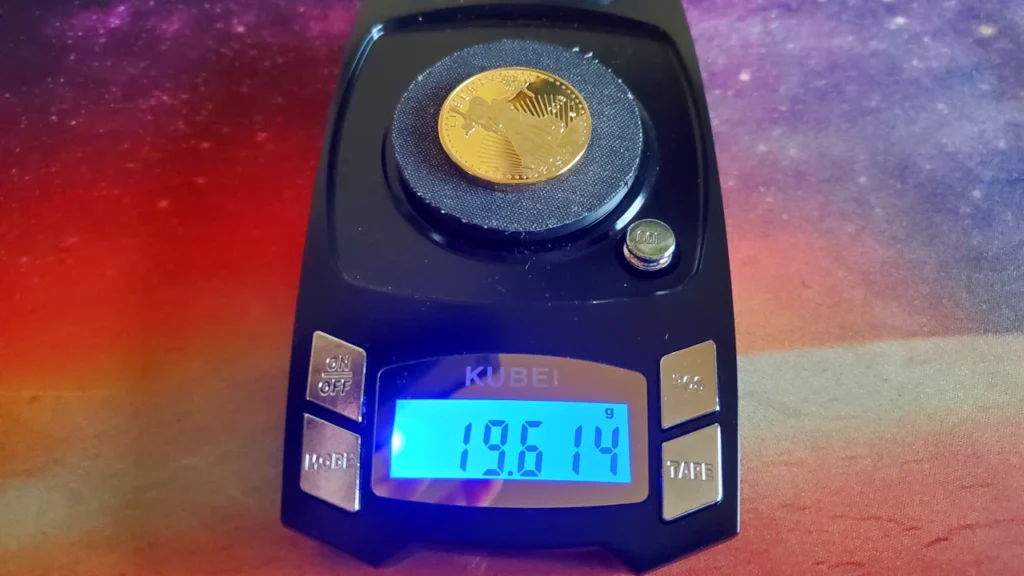
Dimensions verification procedure
Tools used:
Measure the dimensions of the object with a precision caliper and compare the values with the standard ones. Allow for a small tolerance for the manufacturing process or for possible wear. You can retrieve the standard dimensions of the object in the following ways:
- In case of a coin search diameter and thickness on Numista.com,
- In case of a bar search base, height and thickness on the manufacturer’s website.
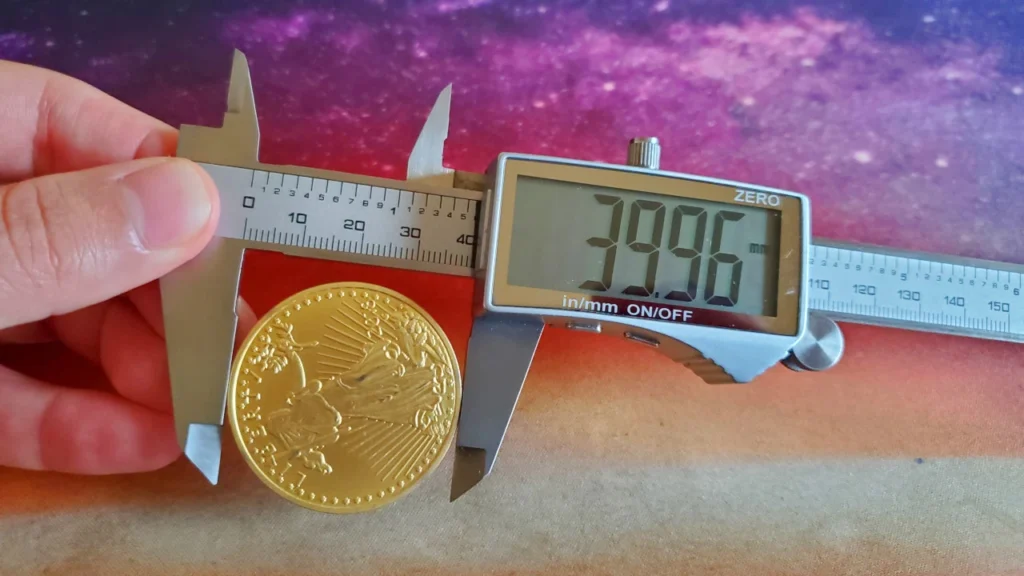
#4. Density 💧
Attention:
Not suitable for packaged bars.
Each material has its own particular density, that is, the ratio between mass and occupied volume. Only tungsten has a density very similar to that of gold and is therefore sometimes used in the manufacture of the best fakes. However, tungsten manifests all the other properties differently and therefore detecting fakes with the other tests becomes very simple.
Normally this test is not necessary to verify investment gold and silver as they are presented in formats that are easily verifiable with all the other tests. However, it may happen that you find yourself with an ingot or precious metal with a somewhat particular shape and consequently proceeding with this type of verification may make sense.
👉 Read also: Calculate Density to Spot Fake Gold 🎬
Verification procedure
Tools used:
- Precision scale
- Containers for water and thin wire
Take a container slightly larger than the object you want to check, fill it almost completely with water and place it on a precision scale suitable for the mass to be supported.
Tie the object whose volume you need to measure with a thread or string, as thin as possible, and immerse it in the water in the container, making sure that it never touches the bottom but is at the same time completely immersed. In the meantime, write down the value in grams that the scale shows.
Now dry the object, remove the container, weigh the object just immersed and write down its mass in grams.
Finally, divide the latter with the one noted before and you will obtain its density. Compare it with the densities of the most common metals below to estimate their composition:
👉 Read also: Parameters for Precious Metal Verification 📊
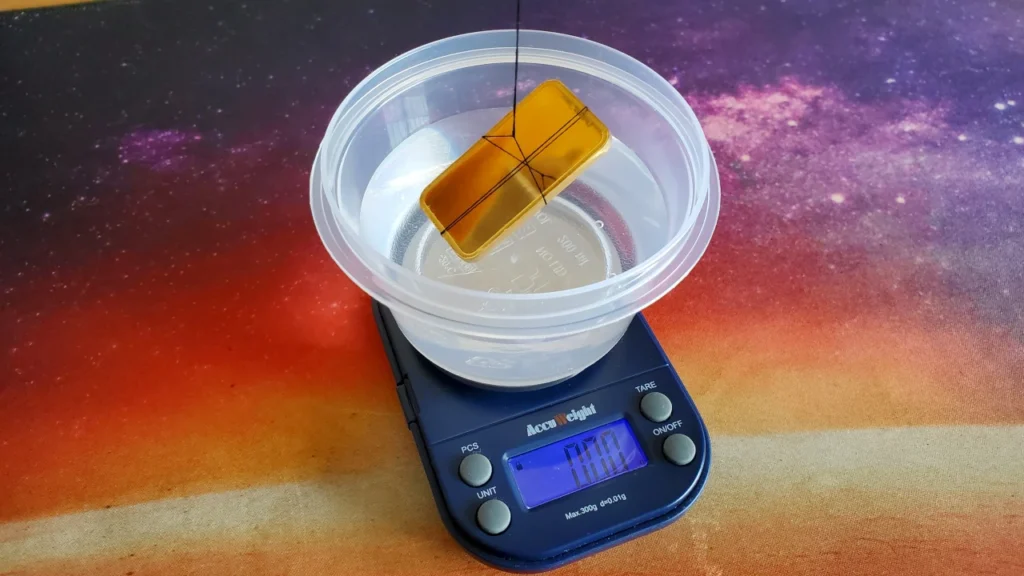
#5. Sound frequency 🎶
Attention:
Not suitable for packaged bars and not very suitable for large casting ingots.
Each material, or each alloy, has its own particular resonant frequency that we use to authenticate the object it composes. This test is so valid in verifying what composes a coin or a bar to the point that it makes all other checks almost superfluous.
Verification procedure
Tools used:
We pinch the object and hit it, without too much force, with a pencil or a wooden stick. Let it ring and evaluate its authenticity based on the sound it makes. It is also possible to make the object ring without buying the appropriate clamps, but by placing it on the protruding bone of the thumb, as shown in the figure on the right just below.
To be able to confirm whether the sound emitted by your coin or your ingot is correct or not, you can compare it by consulting:
- This page created specifically to be able to compare the sound of authentic gold and silver with fakes,
- Sound analysis app, specifically created by third parties to verify the authenticity of each specific coin.
Imperfections in the alloy of the object
Sometimes some coins may produce a more muted sound both in intensity and duration than expected, giving the impression of being fake. This can happen due to micro-fractures or alterations that are formed inside the coin for some reason. In this case, I invite you to verify the coin with more tests.
👉 Leggi anche: Monete d’Oro che Non Suonano Come Dovrebbero
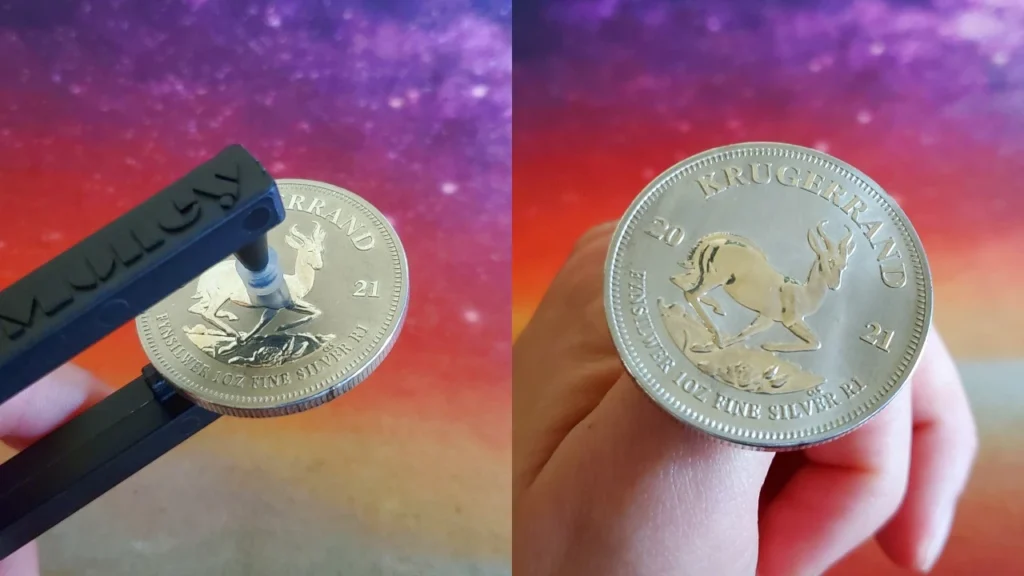
#6. Diamagnetism 🧭
Attention:
Not always suitable for coins.
Materials can be paramagnetic or diamagnetic. In the presence of an external magnetic field, a paramagnetic material becomes slightly attractive, while a diamagnetic material becomes slightly repulsive. Gold, silver, copper, and lead are all diamagnetic metals, which allows us to rule out some fakes by this property.
👉 Read also: Using Diamagnetism to Spot Fake Gold 🎬
Below you can find the magnetic susceptibility of the main precious and non-precious metals. A positive value indicates paramagnetism, while a negative one indicates diamagnetism:
👉 Read also: Parameters for Precious Metal Verification 📊
Verification procedure
Tools used:
Take a precision scale (I recommend a precision of at least 0.001g) and place a riser made of light and non-magnetic material about 8-10cm high, such as polystyrene, on top of the plate. Place some neodymium magnets on top of it. The riser is essential to ensure that the magnetic field interferes as little as possible with the functioning of the scale.
Now slowly lower the object you want to test from above, without ever touching the magnets. Test the object front and back and in multiple points in order to obtain optimal coverage.
A positive mass reading indicates a prevalence of diamagnetic material, which suggests the absence of tungsten. A negative mass reading indicates, instead, a prevalence of paramagnetic material and therefore the possible presence of iron or tungsten.
Impurities in the object that alter the outcome
This test is not always suitable for coins, as the verification of some of them could give a false positive. In reality, this can happen due to the presence of micro impurities due to low quality standards of the mint or other factors. In this case, I invite you to verify the coin with more tests.
👉 Read also: (ITA 🇮🇹 Only) Metalli Diamagnetici ma che Presentano Paramagnetismo
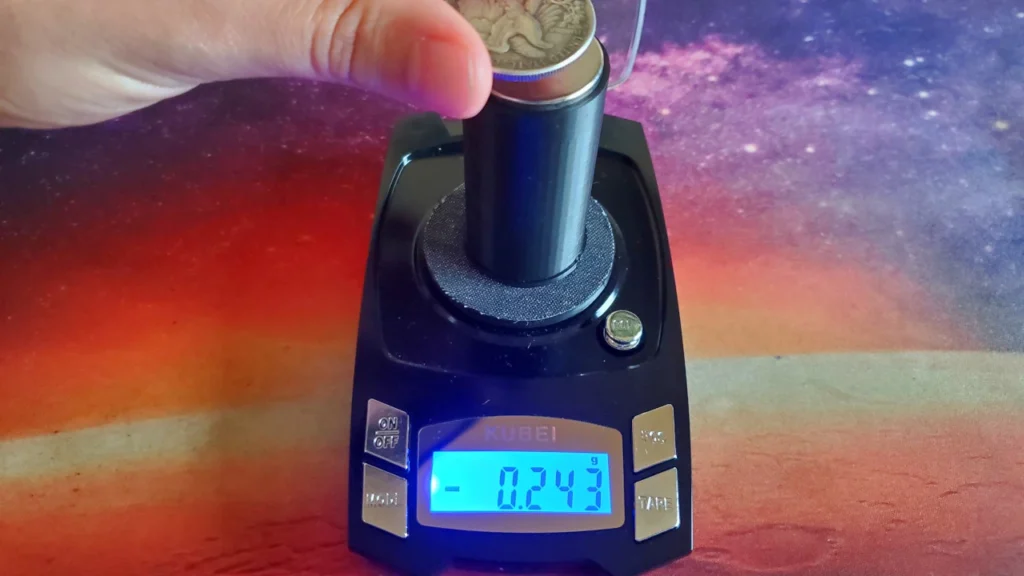
#7. Sound speed 🔊
Attention:
Only needed to check casting ingots.
Sound propagates at a different speed in each material. We can therefore exploit this characteristic to “examine” the inside of an object in order to verify that everything is in order, as it should be.
To do this operation we need an ultrasonic thickness tester. Its main application in this field is to be able to verify the internal composition of the casting ingots in a few seconds, without having to resort to coring or casting. Furthermore, the tester has a modest price within everyone’s reach.
Verification procedure
Tools used:
First, measure the thickness of the object you are going to check with a caliper.
Next, take the ultrasonic thickness tester and set the speed of the waves to that of the material the object should be made of. Wet the head with the appropriate gel and take the measurement in several points.
If the value measured with the caliper coincides with that of the ultrasonic tester, within the limits of tolerance, it is undoubtedly authentic. Otherwise it will be a fake.
All testers should have the speed of sound in most materials reported on the instrument itself, on the packaging or in the instruction booklet included. However, if it is not there, you can find it here:
👉 Read also: Parameters for Precious Metal Verification 📊
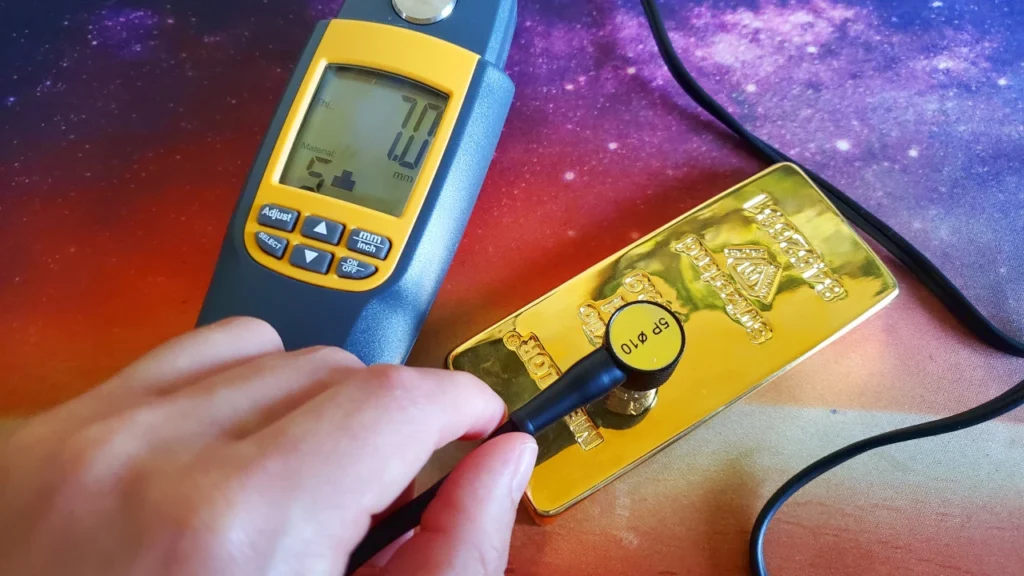
#8. Other unreported tests 🧪
I have decided to omit some gold and silver verification tests because they are destructive, compromising the integrity of the metal and reducing its value. In addition, some are too expensive, making the analysis inconvenient. Others are unnecessary, since the methods already mentioned provide more than sufficient analysis. Finally, some tests are cumbersome, requiring equipment that is difficult to transport or handle.
- XRF Tester: used to determine the exact composition of a few millimeters of an object’s surface. It is a non-destructive test and an excellent substitute for the acid test. Suitable for businesses with large turnovers, the prices are very high and range from 10,000 EUR to 40,000 EUR.
- Acid test: used to verify the purity of the precious metal but it is a test usually carried out for the verification of jewelry rather than investment products such as coins or ingots. It is a destructive test that alters the object, therefore I do not use it.
- Electrical conductivity tester: used to verify the authenticity of a coin or an ingot, even through any packaging. The price is around €1,000, here you can see an example of the object in question. It is a very useful tool for verifying large quantities of objects, but for an amateur or small businesses it is not necessary.
- Hydrostatic balance: it is used to determine the density of an object by measuring its volume using Archimedes’ principle. However, it is a rather bulky instrument, more suitable for static use than for portable use.


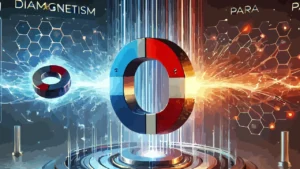

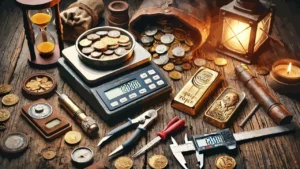

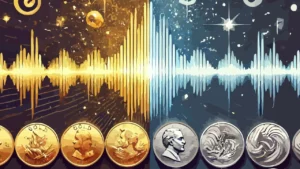

Leave a Reply